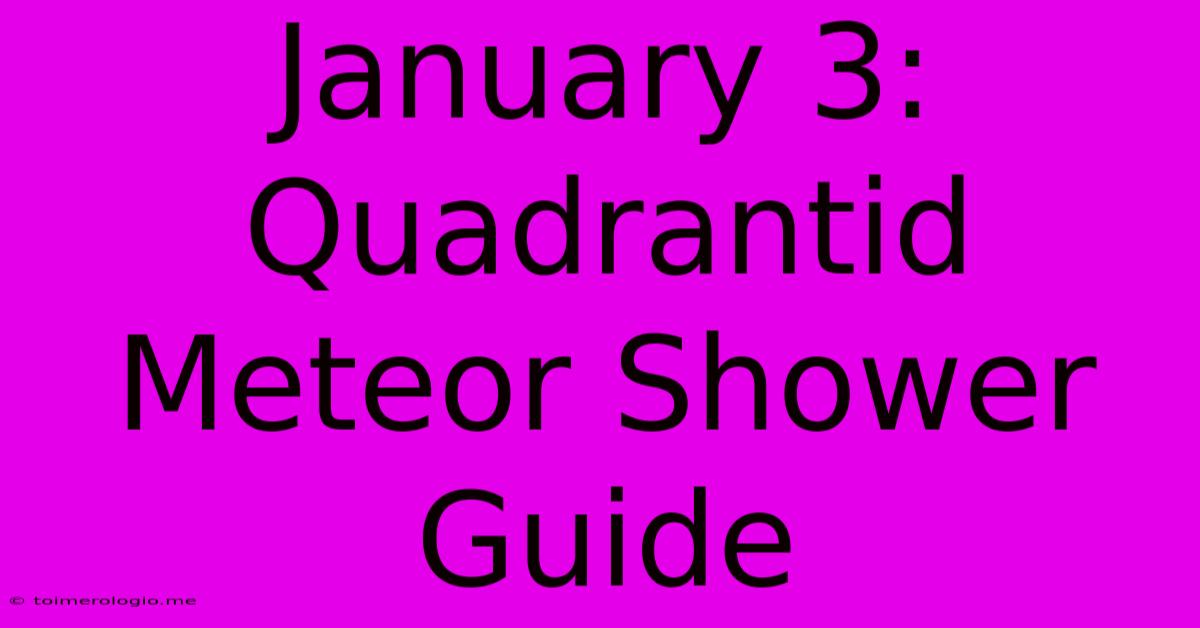January 3: Quadrantid Meteor Shower Guide

Discover more detailed and exciting information on our website. Click the link below to start your adventure: Visit Best Website toimerologio.me. Don't miss out!
Table of Contents
January 3: Quadrantid Meteor Shower Guide
The new year brings with it a celestial spectacle: the Quadrantid meteor shower. While often overshadowed by the more famous Perseids and Geminids, the Quadrantids pack a punch, offering a potentially dazzling display of shooting stars under the right conditions. This comprehensive guide will equip you with everything you need to know to witness this stunning astronomical event on January 3rd and beyond.
Understanding the Quadrantids
The Quadrantids, unlike many meteor showers linked to comets, are believed to originate from asteroid 2003 EH1, a near-Earth object with a unique orbit. This asteroid, possibly a fragment of a larger comet, sheds dust and debris that intersects Earth's orbit annually. When these particles enter our atmosphere at high speeds, they burn up, creating the fiery streaks we know as meteors.
What Makes the Quadrantids Unique?
Several factors distinguish the Quadrantids from other meteor showers:
-
Short Peak: The Quadrantids boast an exceptionally short peak, lasting only a few hours. This narrow peak window requires precise timing to maximize your viewing experience. Unlike showers that offer several nights of decent activity, the Quadrantids demand careful planning.
-
High Zenith Hourly Rate (ZHR): Despite the short peak, the Quadrantids can offer a spectacular display. Their ZHR, representing the number of meteors a single observer might see under ideal conditions, can reach up to 120 meteors per hour. This makes it one of the most prolific meteor showers of the year.
-
Radiant Point: The radiant, the point in the sky from which the meteors appear to originate, is located in the constellation Boötes, near the former constellation Quadrans Muralis (hence the name). Finding this radiant is crucial for optimal viewing, as meteors will appear to streak away from this point.
Maximizing Your Quadrantid Viewing Experience
To witness the best possible Quadrantid meteor shower, careful preparation is key. Follow these steps to ensure a memorable experience:
1. Find a Dark Location
Light pollution significantly impacts meteor shower viewing. Escape city lights and find a location with minimal light interference. Rural areas, national parks, or even your backyard away from streetlights are ideal. The darker the sky, the more meteors you'll see.
2. Check the Weather Forecast
Clear skies are absolutely essential. Cloudy conditions will completely obstruct your view. Check weather forecasts leading up to January 3rd and choose an alternative night if necessary. Cloud cover can vary significantly across short distances, so check local forecasts very carefully.
3. Time Your Viewing
The peak of the Quadrantid meteor shower is usually very short, lasting only a few hours. This usually occurs around January 3rd-4th, so consult resources such as NASA's website or astronomy apps for the precise peak time in your location. Consider staying up for several hours around the peak to maximize your chances of seeing numerous meteors. The radiant will be highest in the sky during the pre-dawn hours.
4. Dress Warmly
Even if the temperature doesn't seem extreme, nights can get surprisingly cold. Bundle up in warm layers, hats, gloves, and scarves to stay comfortable throughout the night. Remember, you'll likely be standing still for extended periods, making you more susceptible to the cold.
5. Bring Supplies
Your comfort is crucial. Bring a comfortable chair or blanket to lie down on. Consider a thermos of hot chocolate or coffee to stay warm and alert. A red flashlight will allow you to read your star charts or maps without ruining your night vision. Binoculars aren't necessary, as meteors are best seen with the naked eye.
6. Allow Your Eyes to Adjust
It takes about 20-30 minutes for your eyes to fully adapt to the darkness. Avoid looking at bright screens (phones, tablets) during this adjustment period. Once adapted, your eyes will be far more sensitive to fainter meteors.
7. Identify the Radiant Point
Use a stargazing app or a planisphere to locate the constellation Boötes and its radiant point. While you don't need to stare directly at the radiant, knowing its location will help you spot meteors radiating from it.
Beyond the Peak: Observing the Quadrantids
While the peak is short, you may still see Quadrantid meteors for several days before and after January 3rd, although at significantly lower rates. Even these fainter displays can be worthwhile for experienced stargazers.
Photographing the Quadrantids
Capturing the beauty of the Quadrantids requires specialized equipment and technique. This involves using a DSLR or mirrorless camera with a wide-angle lens, a sturdy tripod, and a long exposure setting. Research astrophotography techniques beforehand to increase your chances of success.
Conclusion
The Quadrantid meteor shower offers a stunning celestial display for those willing to brave the cold and plan accordingly. By following this comprehensive guide, you will significantly enhance your chances of witnessing this spectacular event. Remember, patience and preparation are key to a truly unforgettable experience. Clear skies and happy viewing!

Thank you for visiting our website wich cover about January 3: Quadrantid Meteor Shower Guide. We hope the information provided has been useful to you. Feel free to contact us if you have any questions or need further assistance. See you next time and dont miss to bookmark.
Also read the following articles
| Article Title | Date |
|---|---|
| Illinois Basketball 3 Takeaways From Oregon Win | Jan 05, 2025 |
| Watch The Quadrantids Tonight | Jan 05, 2025 |
| Glaser Refrains From Lively Baldoni Humor | Jan 05, 2025 |
| Analyzing Illinois Win 3 Key Takeaways | Jan 05, 2025 |
| Observing The Quadrantid Meteor Shower | Jan 05, 2025 |
